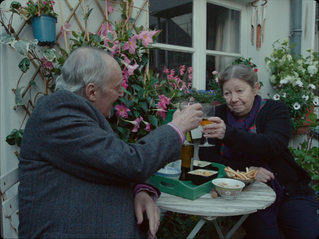Tracing the Screen
- Jessica Moore

- Jul 28, 2019
- 3 min read
While each decade seeks to exercise cinematic innovation, each produces seminal, essential films which exhibit the edification and creativity of filmmaking. Below are three, carefully selected films per decade which best represent the era from which they were produced, thematically and stylistically.
1920s: mobility and modernity

Man With A Movie Camera (1929)
directed by Dziga Vertov
Centres the city as its protagonist, essential at demonstrating the possibilities and humanity of the camera.

Un Chien Andalou (1929)
directed by Luis Buñuel
A surreal and grotesque short film and an icon of modernist abstraction.

Metropolis (1929)
directed by Fritz Lang
An epic of the Weimar period, revered for its groundbreaking use of special effects and set design.
1930s: the era of grandeur

M (1931)
directed by Fritz Lang
Essential for its nascent experimentalism with sound cinema.

The Blood of a Poet (1932)
directed by Jean Cocteau
Demonstrative of the art of visual poetry and French avant-garde.

The Wizard of Oz (1939)
directed by Victor Fleming
One of the first uses of Technicolour and an icon of American popular culture.
1940s: refining the medium

Brief Encounter (1945)
directed by David Lean
Experiments with circularity in narrative structure and refines the romantic blockbuster.

The Red Shoes (1948)
directed by Michael Powell and Emeric Pressburger
A monument of British cinema and essential for its intricate display of special effects.

Bicycle Thieves (1948)
directed by Vittorio De Sica
An odyssey of Italian neorealism which refines the meticulous art of story-telling.
1950s: an act of departure

Sunset Boulevard (1950)
directed by Billy Wilder
A departure into noir and self-oriented criticism of Hollywood.

Night and Fog (1955)
directed by Alain Resnais
Entirely unfiltered in its exhibition of the Holocaust and its violence, an essential in the art of documentation.

Good Morning (1959)
directed by Yasujirō Ozu
A master at resisting narrative complexity in exchange for the art of simplicity.
1960s: crises of identity

Persona (1966)
directed by Ingmar Bergman
Highly stylised and enigmatic performances that embody a collapse of identity.

The Graduate (1967)
directed by Mike Nicholls
A quintessentially American film which satirises existential crises, malaise and coming-of-age narratives.

Funeral Parade of Roses (1969)
directed by Toshio Matsumoto
A master at tracing the subversive sex culture of Japanese non-binary and trans individuals, revered for its experimental combination of documentary footage and avant-garde cinematography.
1970s: the macabre

Cries and Whispers (1972)
directed by Ingmar Bergman
Influential for its powerful depiction of emotional and physical trauma, a cinematic extreme.

The Texas Chain Saw Massacre (1974)
directed by Tobe Hooper
Gritty and relentless for how it positions graphic violence as a spectacle of morbid fascination and escapism.

House (1977)
directed by Nobuhiko Obayashi
A cult-classic Japanese horror that is subtextually responsive to Hiroshima’s nuclear bombings, advancing the genre from B-movie detritus into highly creative, reflective cinema.
1980s: fragility of mind and memory

Paris, Texas (1984)
directed by Wim Wenders
Essential for its melancholy and fractured depictions of memory and loss.

Betty Blue (1986)
directed by Jean-Jacques Beineix
A fragile landscape which captures the inarticulacy and complexity of modern relationships and mental illness.

Blue Velvet (1986)
directed by David Lynch
Lynch’s epic of surrealism, deconstruction, and mental instability, all of which replace narrative familiarity.
1990s: retrospect

Paris is Burning (1990)
directed by Jennie Livingston
A stylish and devastating masterpiece of the documentary genre which turns towards the origins of black queer subcultures fraught with external violence.

My Own Private Idaho (1991)
directed by Gus Van Sant
Episodic and divisive amongst critics, a 90s essential for its commitment to capturing the subjectivity of a narcoleptic prostitute who grapples with unresolved traumas.

The Last Days of Disco (1998)
directed by Whit Stillman
Coolly retrospective of early 80s club culture and New York bourgeoisie.
2000s: the established global cinema

Spirited Away (2001)
directed by Hayao Miyazaki
Highly imaginative and essential in amongst the millennial rise of animation.

In The Mood For Love (2001)
directed by Wong Kar-wai
A breathtaking romantic drama, frequently listed as one of the greatest films of the early twenty-first century and of all Asian cinema.

The Beaches of Agnès (2008)
directed by Agnès Varda
Celebrated French filmmaker who influenced the French New Wave, Agnès Varda interpolates significant places from her career into what has been described as an autobiographical essay of a film.
The seminality of these films is because they are anomalous and representative in simultaneity. They espouse restraint in displaying the obvious and their experimentalism is unceasingly influential. In other words, they are deviant but entirely indispensable.








Comments